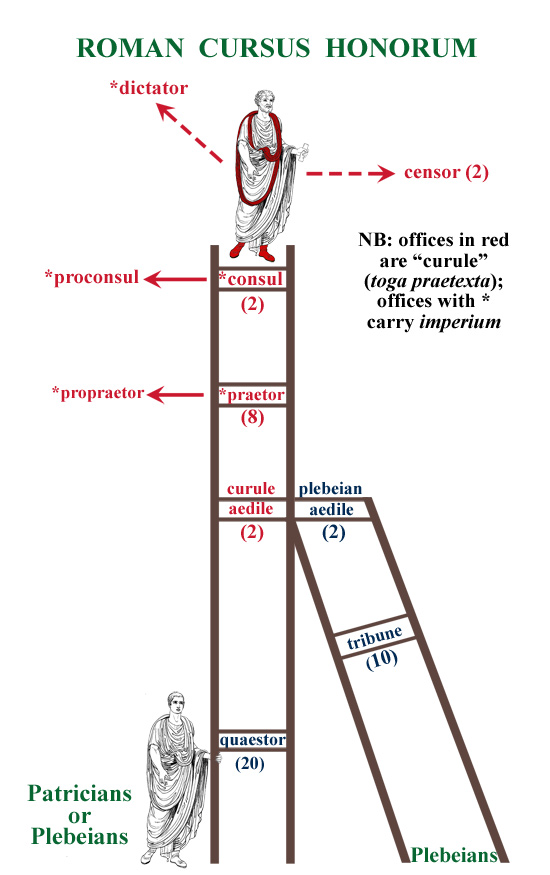

NB: This diagram shows the ladder of political advancement (cursus honorum) during the late Republic. The straight ladder shows the typical path of advancement (theoretically open to all freeborn male citizens), beginning with election to quaestor, the lowest office, and proceeding to consul, the highest (of course very few men made it that far; it was quite exceptional when a man like Cicero, who did not come from a noble family, was elected consul). Red text designates “curule magistrates,” who had the right to sit on a special ivory folding stool (sella curulis) as a symbol of their office; they also had the right to wear the purple-bordered toga (toga praetexta). Offices marked with an asterisk carried imperium, the highest political authority, which included the right to command an army, to interpret and carry out the law, and to pass sentences of death. Magistrates whose title began with “pro” were in charge of provinces; the Senate normally conferred these after the men had finished their term of office in Rome. The more important provinces, especially those requiring large military forces, were assigned to ex-consuls, while the less significant provinces were governed by ex-praetors.
During the Empire, most of these offices remained in place, though their functions changed. Most significantly, imperium was now reserved for the emperor, and advancement in rank proceeded in orderly stages based on conditions laid down by the emperors rather than through competitive electioneering. Thus the cursus honorum changed from a ladder of power (with important social status attached) to a ladder of primarily social rank and status. The cursus honorum was, of course, reserved for men; during the entire period of Roman history, women were prohibited from holding political office, though in the Empire their roles as mothers, wives, and daughters of emperors gave a few women very high social status and even a kind of indirect rank. Even elite women who were not members of the imperial family sometimes claimed the rank of their fathers or husbands (e.g., as consulares feminae, “consular women”).
These principles evolved under the impetus of the “conflict of orders,” a struggle between two social classes, the patricians and plebeians, that occurred primarily during the fifth and fourth centuries BCE.
2 *consuls—chief magistrates who convened and presided over the Senate and assemblies, initiated and administered legislation, served as generals in military campaigns, and represented Rome in foreign affairs. Consuls could appoint and/or serve as *dictator for up to 6 months in times of emergency when the constitution was suspended. When their term of office was completed, consuls usually governed a province as *proconsul.
8 *praetors—served primarily as judges in law courts, but could convene the Senate and assemblies; they assumed administrative duties of consuls when these were absent from Rome. When their term of office was completed, praetors might govern a province as *propraetor.
2 censors—elected every 5 years for terms of 1½ years; revised lists of senators and equestrians; conducted census of citizens and property assessments for tax purposes; granted state contracts.
4 aediles—supervised public places, public games, and the grain supply in the city of Rome; 2 were required to be plebeians, and the other two (who had more status) could come from either order; the latter 2 were called curule aediles.
10 tribunes—had to be plebeian, because the office was established to protect the plebeians from arbitrary actions of magistrates. Hence the primary power of tribunes was negative; they could veto the act of any magistrate and stop any official act of administration. They were by law sacrosanct, meaning that anyone who attacked them physically could be immediately and summarily killed; they could convene the Senate and assemblies and initiate legislation.
20 quaestors—administered finances of state treasury and served in various capacities in the provinces; when elected quaestor, a man automatically became eligible for membership in the Senate, though censors had to appoint him to fill a vacancy
These were theoretically composed of all males who were full Roman citizens, though individuals had to attend in person in order to vote. No debate from the floor was possible, and votes were counted in groups, not individually (the vote of each group was determined by the vote of the majority of individuals in that group). For more information about voting, see Notes on Politics.
Assembly of the Curiae (comitia curiata): oldest assembly; by the late Republic had mostly ceremonial and clan functions.
Assembly of the Centuries (comitia centuriata): elected consuls, praetors, censors; declared war; served as court of appeal for citizens sentenced to death. The 193 centuries were determined by wealth, and the richest centuries were also the smallest, so individual votes in these counted more heavily (when a majority of the 193 votes was reached, voting was stopped, so some of the largest centuries rarely got to cast votes).
Assembly of the Tribes (comitia tributa): elected all other magistrates; voted yes or no on laws; the 35 tribes were originally determined geographically and then passed on by birth. A subgroup of this assembly, the Concilium Plebis, was open only to plebeians. This plebeian assembly elected the magistrates open only to plebeians (tribunes and plebeian aediles). After 287 BCE, the measures passed by the Concilium Plebis (plebiscita) had the force of laws binding on the whole state.
Barbara F. McManus, The
College of New Rochelle
bmcmanus@cnr.edu
revised July,
2003